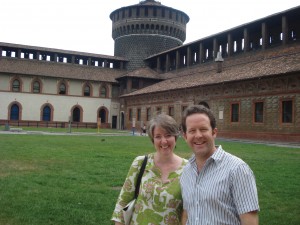
Truman professor Julia DeLancey and Truman alumnus John Garton (’97) in the courtyard of the Castello Sforzesco in Milan, Italy.
Leonardo da Vinci may be the most recognized name in art, but few art enthusiasts ever have the chance to see his paintings and writings up close. Last summer, Truman alumnus John Garton (’97) had the opportunity to study the work of da Vinci in Florence, Italy, along with Julia DeLancey, a professor of art and art history at Truman, who inspired Garton to become a professor. Both DeLancey and Garton, who is an assistant professor in the Department of Visual and Performing Arts at Clark University in Worcester, Mass., were among a group of 25 scholars who spent three weeks in Florence as part of a National Endowment for the Humanities Summer Institute for a seminar entitled “Leonardo da Vinci: Between Art and Science.”
The group participated in site visits to see da Vinci’s works first hand. One visit included the da Vinci painting collection at the Uffizi Gallery and a conservation lab where they were able to observe two paintings being preserved. During the seminar, the group also heard lectures by da Vinci experts and engaged in discussions with fellow participants.
During a trip to Milan, Italy, the scholars had a chance to speak with conservators working on a room da Vinci frescoed and to view “The Last Supper.” “While examining this famous painting, the group just looked at it for 15 minutes without discussion in order to fully take in the experience,” said DeLancey. “Even still, half of the group walked out of the room backward to keep looking as long as possible.”
The scholars also worked on individual projects as part of the institute. DeLancey noted that motion was of great interest in da Vinci’s time, and during the Renaissance, movement was believed to be connected to how people felt inside. Like any motion, the act of kneeling revealed something about a person’s inner state, and DeLancey’s project examined a notebook page in which da Vinci was working on an anatomical study of the leg from the middle of the thigh to the foot. On the page, he also wrote about the body’s functions and how these affect sculptors and painters. “I feel much more comfortable talking about da Vinci and have the tools to help students study him,” said DeLancey.
For his project, Garton researched da Vinci’s early drawings of grotesque heads and their relationship to renaissance portraiture. “In particular, I sought to understand one of da Vinci’s early examples, Uffizi #446E, and its relation to the later drawings now in the Chatsworth Collection,” said Garton. “The effect of such images, either singularly or collectively, is to subvert his audience’s basic assumptions about portraiture. The subversion extends even to Alberti’s more general notion of the commemorative purpose of painting. By refining and perfecting ugliness through purposeful distortion of certain facial features, da Vinci shaped the discernment of the grotesque as a creative marvel.”
The conference also encouraged interdisciplinary thinking, and the group included professors from various backgrounds, including art and engineering, and each member brought varying perspectives to the discussions. “People were unfailingly collegial and supportive and engaged,” DeLancey said. Garton noted that looking at so much da Vinci material with anatomists, geologists, historians of technology, a poet laureate and other interesting specialists has allowed him to teach the artist’s work from a variety of perspectives that are sometimes under-represented in art history.
Both Garton and DeLancey plan to continue pursuing their research on da Vinci.

